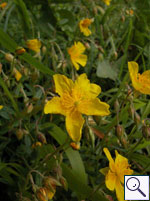|
||||||
|
HELIANTHEMUM. Rock-roses. [Cistaceae] |
|
|
Eight species and subspecies Helianthemum are recorded in Britain. These include Common Rock-rose (H. nummularium) and White Rock-rose (H. apenninum). Four British miners are recorded on Helianthemum. A key to the European miners recorded on Helianthemum is provided in Bladmineerders van Europa. |
 Common Rock Rose Helianthemum nummularium |
|
Key for the identification of the known mines of British |
1a > Leaf-miner and case-bearer: The larva lives outside the mine, protected by a case, and feeds on the underlying plant tissues via a hole cut in the epidermis. From that point it eats away as much leaf tissue as it can reach without fully entering the mine. Mine does not contain frass (Coleophora species) |
1b > Leaf-miner, but not a case-bearer: The larva lives mainly inside the mine. Mine usually contains frass. In later instars the larva may live sandwiched between two more or less circular sections cut from the leaf. |
2a > Leaf-miner and case-bearer: The larva builds a case from leaf fragments, adding sections as it grows, creating a long narrow and distinctive case. A large, composite leaf case of 10-15 mm length, the fully developed case consisting the three succesive leaf fragments. Case light brown, bivalved; mouth angle c. 45°. |
|
Coleophora ochrea (Haworth, 1828) [Lepidoptera: Coleophoridae]. |
2b > Leaf-miner and case-bearer: The case resembles that of C. violacea, but does not lie so flat again the leaf as this species (having a mouth angle of 30 to 50°). C. violacea also has a case which bulges in the middle, whereas in C. potentillae the case tapers towards the posterior. Immediately after emergence the larva makes a full depth, quickly widening, corridor, with frass as small grains in a broad central band. Finally results a blotch of 2 x 5 mm, from which the youth case is cut. The fully developed case is a hairy, greyish brown to silver grey lobe case of about 1 cm long, with a clearly laterally compressed end; the mouth angle is about 90°. The case is difficult to separate from that of C. ochripennella. |
|
Coleophora potentillae Elisha, 1885 [Lepidoptera: Coleophoridae]. |
3a > Leaf-miner: Young larvae make a number of rather large, untidy full depth mines. The mines contain little or no frass. The lower-surface opening, by which the larva has entered the mine, is irregularly roundish. Older larvae live free on the plant. The larva pupates in a cocoon near the ground |
|
Adscita geryon (Hübner, 1813) [Lepidoptera: Zygaenidae]. |
3b > Leaf-miner: Initially a gallery is made and filled with frass. It is widened abruptly into a blotch, which absorbs the gallery and may occupy the whole leaf. The frass may then be dispersed or heaped in the blotch. A larva may mine more than one leaf before it vacates the mine. Corridor, densely packed with frass, suddenly widening into a blotch that often occupies the entire width of the leaf, then overrunning the initial corridor. Frass in the blotch disersed or clumped. The larvae can leave the mine and restart elsewhere. Pupation outside the mine. Pupation in a silk cocoon among leaf litter (UKMoths; British leafminers). |
|
Mompha miscella (Denis & Schiffermüller, 1775) [Lepidoptera: Nepticulidae]. |
| Last updated 05-Jul-2019 Brian Pitkin | ||
